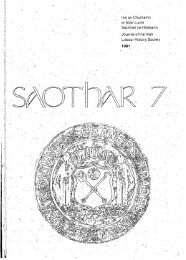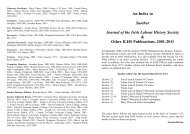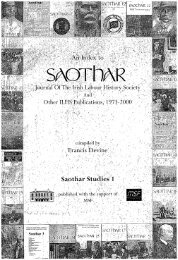124 SAOTHAR 13James Connolly would deliver an address to them as a possible candidate. The minutes of23 Novemberreport back that 'J ames Connolly gave an outline of his own position as the selected candidate for WoodQuay Ward stating that the final understanding was that though he was running as the candidate of theUnited Labourers, this should not prevent him from giving expression to his views as a socialist duringthe contest' .17 Connoll y' s campaign mainly consisted of open-air meetings, 'the stance favoured beingin New Street' .18 Such public meetings would have brought Connolly into direct contact with Dublin'simmigrant Jewish population, since New Street was a direct continuation of Lower Clanbrassil Street,the principal thoroughfare of the South Circular Road area of Dublin which had become known as'Little Jerusalem'. The Jewish population of Dublin, while remaining relatively small even at itsmaximum, rapidly grew at the turn of the century as refugees fled from pogroms and persecution in theRussian Empire. Numbering only 352 in 1881, Dublin's Jewish population increased to 1,057 in 1891,to 2,169 in 1901 and to 2,965 in 1911. 19 When the future founder of Sinn Hin and first President ofthe Irish Free State, Arthur Griffith, gave full support to the anti-semitic campaign of the Redemptoristsin Limerick, he would denounce these refugees from Tsarist persecution in the following terms: 'Nothoughtful Irish man or Irish woman can view without apprehension the continuous influx of Jews iritoIreland ... strange people, alien to us in thought, alien to us in sympathy, from Russia, Poland ... ' etc. 2DSuch refugees, who hailed mainly from Lithuania, were among the electors of Wood Quay Ward.Connolly's approach was to reach out to them, particularly to the proletarian and semi-proletariannumbers among them. As the late Louis H yman noted, ' Among the Jews of foreign birth listed in Dublinin the Census of 1901 there were 261 drapers, 223 pedlars and hawkers, 200 students and scholars, 88commercial travellers, 72 tailors, 66 domestic servants and 64 general dealers' .21 In that year two suchJewish immigrant workers, Barnet and Abraham Volkes of Pleasant Street, would become membersof the ISRP, having been previously members of the SDF in Salford. 22During the years 1901 to 1911 Jews came to constitute a majority of the inhabitants in many of thestreets in the Wood Quay Ward. 23 The circumstances of the workers among them have been describedas follows by Maurice Levitas, the son of one such worker who emigrated to Dublin from the Lithuanianprovince of Kovno in 1911 but whose circumstances were similar to those of the Jewish -workers towhom Connolly had appealed in 1902:'i hail from the South Circular Road neighbourhood - and your researches into the Jewish input into tradeunions in Ireland reminds me of my father's part in the Tailors' and Pressers' Union ... My father, HarryLevitas, tried a number of ploys when we lived in Dublin in order to gain a living. Like some other Jewsin Dublin he tried 'travelling' around the countryside, collecting rags and metal etc. for sale to dealers inthese salvage commodities. Buthe was not successful at this. In the main he worked for a wage as a presserin the tailoring trade and since he was left-wing in his politics, he played a part in his trade union. Indeed·the main impression we all have of my father is his strong trade union principles. The origin of all this washis association in Lithuania, as a very young man, with the Poale Zion (or Labour Zionists) - a kind ofJewish socialist movement' .24Other Lithuanian Jewish immigrants in Dublin's 'Little Jerusalem' would have been influenced bythe ideas of the Jewish Social-Democratic Party known as the Bund which stood for Je'Yish nationalautonomy within Russia, Poland and Lithuania. It was in Vilna, known as 'the Jerusalem of Lithuania' ,that the Bund had been founded in 1897, its full name being 'The General Jewish Workers' Union(Bumf) in Russia and Poland' (Lithuania was added later). The following year the Bund itself hostedthe founding Congress of the Russian Social Democratic Workers Party (RSDWP), of which the Bundbecame an autonomous member. The Bund seceded from the RSDWP in 1903, rejoined itin 1906, andafter the Russian Party irrevocabl y split between Bolsheviks and Mensheviks, the B und affiliated to thelatter in 1912.25Connolly had been most impressed by the Bund and he greeted its development with particularenthusiasm. He wrote: 'The Socialist movement is developing at a remarkable rate amongst the J ewis,h
DOCUMENT STUDY 125proletariat of the Russian Empire. The organisation known as 'The Union ofJewish Workmen of Russiaand Poland' actually issues eight journals from its secret printing press - more than any [other socialist]organisation in the Empire' .26But how was ConnoUy to relate to those Russian Jewish immigrants who were now among theelectors of Wood Quay Ward and how could he draw on the sympathy which they had for the Bundistand other socialist currents which were rapidly developing among their Machatonnim un Landsleit inder Heim (relatives and fellow-countrymen in their native provinces of Tsarist Russia)? Language wasa major difficulty. At the 1923 Annual Meeting of the Irish Labour Party and Trade Union Congress,aJewish tailor representing the Tailors' and Pressers' Union, Isaac Baker, had made a briefbuteloquentspeech against 'any discrimination between Jew and Gentile, so long as either does his work right' PButwhile the 1911 census form had shown that lsaac Baker could now 'read and write', the earlier 1901census had recorded that at the time of Connolly's election campaign this Russian-born immigrantworker 'cannot read'.211 The extent to which this would be a major problem for newly arrived immigrantworkers in Dublin was most clearly demonstrated when a new set of rules for the International Tailors',Machinists' and Pressers' Trade Union was registered in 1915. Only the Secretary, Waiter Carpenter,and the one non-Jewish executive member were able to sign their own names in English. An 'X' hadto be entered by each of the fi ve Jewish executive mem bers, with Carpenter certifying on behalf of eachthat it was 'his mark'. ~ It would be a grave mistake to assume that these Jewish workers were illiterate.The census authorities were only interested in whether one could read or write English or speak Irish.For example when the Shamas (beadle) of Dublin's Lennox Street synagogue asked the censusenumerator in 1911 to put down that he himself could 'write and read Hebrew' (and obviously Yiddishas well) and that his wife and daughter could both 'write and read Yiddish', the enumerator's superiorcrossed out these entries and substituted 'cannot read' in each case. 30A Jewish immigrant worker like Isaac Baker, then, while initially illiterate in his neWly-acquiredlanguage of English, would have been highly literate in his native language of Yiddish at the time ofConnolly's 1902 election campaign. It is precisely for this reason that Boris Kahan drafted a Yiddish. language appeal to the Jewish workers of Dublin asking them to vote for Connoll y at their local pollingstation in New Street School. The purpose of the leaflet was to convey to Kahan' sBrider Yiden (Jewishbrothers) in Dublin the clear political message that the Home Rule candidates only represented theinterests of the Balabattim (bosses), that indeed the principal candidate was a Balaboss himself, andthat only the Irish Socialist candidate James Connolly was a true Arbeter Fraint (workers' friend).But Connoll y had more serious obstacles to face than the production of Yiddish-language literature.His principal opponent in the election was the Nationalist publican and patriotic song-writer P J.McCall, who was the author of such famous songs as 'Boolavogue', 'Kelly the Boy from Killane', and'Follow Me Up to Carlow'. McCall ostentatiously paraded the local Catholic priests on his platformto state that 'no Catholic could·vote for a Socialist, nor be a Socialist', while the ISRP itselffurtherclaimed: .'On election night Mr. McCall's public house was crowded till a late hour ... Every public house in theward was a committee room for Mr. McCall and all who were degraded enough to sell their votes couldsoak themselves in liquor, free of expense. Father Staples, Father O'Brien, and Father McGough, of S1.Nicholas of Myra's Chapel inFrancis Street, lent their sanction to all this debauching of the people byjoining the committee responsible for it,and invoking all the terrors of religion against all those who '"voted for Mr. Connolly.'31In such an environment it is not surprising that PJ. McCall of the United Irish League won the seatwith 1,434 votes. A rival Home Ruler, W.H. Beardwood, received only 191 votes. A year laterConnolly was.to recall,'Let us remember how the paid canvassers of the capitalist candidate - hired slanderers - gave a.different
- Page 1 and 2:
JOURNAL OF THE IRISH LABOUR HISTORY
- Page 3 and 4:
ContentsPageEditorial: Labour Histo
- Page 5 and 6:
EDITORIAL 3freedom to participate i
- Page 7 and 8:
CorrespondenceThe Irish Labour Part
- Page 9 and 10:
; ~ ; ,The Decline and Fall of Donn
- Page 11 and 12:
THE DECLINE AND FALL OF DONNYBROOK
- Page 13 and 14:
THE DECLINE AND FALL OF DONNYBROOK
- Page 15 and 16:
·' THE DECLINE AND FALL OF DONNYBR
- Page 17 and 18:
THE DECLINE AND FALL OF DONNYBROOK
- Page 19 and 20:
THE DECLINE AND FALL OF DONNYBROOK
- Page 21 and 22:
THE DECLINE AND FALL OF DONNYBROOK
- Page 23 and 24:
THE DECLINE AND FALL OF DONNYBROOK
- Page 25 and 26:
,'-,;-''''.A PASSAGE TO BRITAIN 23C
- Page 27 and 28:
A PASSAGE TO BRITAIN 25only in the
- Page 29 and 30:
A PASSAGE TO BRITAIN 27clothing._De
- Page 31 and 32:
A PASSAGE TO BRITAIN 29established
- Page 33 and 34:
;:-.",.- .. .", ...... '.:. '
- Page 35 and 36:
LOUIE BENNETI 33feminist movement w
- Page 37 and 38:
:... ~: ."
- Page 39 and 40:
-.- '.LOUlE BENNETT 37While there i
- Page 41 and 42:
LOUIE ~ENNEIT 39Xl's encyclical Qua
- Page 43 and 44:
LOUIE BENNEIT 41Bennett's own relat
- Page 45 and 46:
LODIE BENNETT 43109; IWWU resolutio
- Page 47 and 48:
Essays in ReviewCosherers, Wanderer
- Page 49 and 50:
••• .".'. >. '~"ESSA YS IN RE
- Page 51 and 52:
ESSAYS IN REVIEW 49ConnolIy:Myth an
- Page 53 and 54:
ESSAYS IN ~EVIEW 51tion' in the Int
- Page 55 and 56:
ESSAYS IN REVIEW53International:'I
- Page 57 and 58:
REVIEWScontroversy is real history.
- Page 59 and 60:
REVIEWSJoe Monks was among the earl
- Page 61 and 62:
REVIEWSnolly-Column Song','Proudly
- Page 63 and 64:
REVIEWSresulting from the arrival o
- Page 65 and 66:
REVIEWS,63the book by means of an a
- Page 67 and 68:
REVIEWSlogue, it is hardly surprisi
- Page 69 and 70:
The Team For All Workers ...CULIAIB
- Page 71 and 72:
ESSAYS 69mission and moral refonn.l
- Page 73 and 74:
.. ...... ~.~ -~ .'- '.ESSAYS. 71fr
- Page 75 and 76: ESSAYS 73claimed authority but whic
- Page 77 and 78: ESSAYS 75provided the basis for soc
- Page 79 and 80: ESSAYS 779. For comparisons see E.T
- Page 81 and 82: ESSAYS 7952. Annals of Christ Churc
- Page 83 and 84: ESSAYS' 81Fianna Fail and the Worki
- Page 85 and 86: ESSAYS 83Eireann in 1925 visibly di
- Page 87 and 88: ESSAYS 85recognition of the impract
- Page 89 and 90: ESSAYS 871970, it created the condi
- Page 91 and 92: ESSAYS89The Irish Immigrants' Contr
- Page 93 and 94: ESSAYS" 91Although anti -Catholic p
- Page 95 and 96: ESSAYS 93McCowie played a key role
- Page 97 and 98: :. -,,'.' ',. .~.,:.ESSAYS 95Althou
- Page 99 and 100: ESSAYS 97young girl of their own ba
- Page 101 and 102: SourcesIrish Labour History Society
- Page 103 and 104: SOURCES 101INovember, 1971 to no. 1
- Page 105 and 106: SOURCES 103would claim credit for t
- Page 107 and 108: SOURCES105Sources for Irish Labour
- Page 109 and 110: SOURCES 107NorthWest Archives and L
- Page 111 and 112: SOURCES 109In 1966 the Finnish gove
- Page 113 and 114: TURNINGANEWLEAFThe CPSSUis the larg
- Page 115 and 116: REMINISCENCE 113us due to my politi
- Page 117 and 118: REMINISCENCE 115when Jim was presen
- Page 119 and 120: REMINISCENCE 117of Dail Eireann. 17
- Page 121 and 122: REMINISCENCE 119NotesThe above arti
- Page 123 and 124: DOCUMENT STUDY 121James Connolly in
- Page 125: DOCUMENT STUDY123SOCIAL DEMOCRATIC
- Page 129 and 130: DOCUMENT STUDY 127the support of Je
- Page 131 and 132: DOCUMENT STUDY 12926. The Workers'
- Page 133 and 134: 131BibliographyA Bibliography of Ir
- Page 135 and 136: BIBLIOGRAPHY 133Compton, P.A. Demog
- Page 137 and 138: BIBLIOGRAPHY 135Levine, I. and Madd
- Page 139 and 140: BIBLIOGRAPHY 137Turner, M. 'Towards
- Page 141 and 142: BIBLIOGRAPHY 1394. Land and Agricul
- Page 143 and 144: BIBLIOGRAPHY 141Clogher Record12 (2
- Page 145 and 146: BIBLIOGRAPHY 143Political Research
- Page 147 and 148: BIBLIOGRAPHY 145Pres, 1987.O'Brien,
- Page 149 and 150: 147Notes on Contributorsf onathanBe
- Page 151 and 152: 1901: Ireland's first general union
- Page 153 and 154: ELECTRICAL TRADES UNION .Establishe





